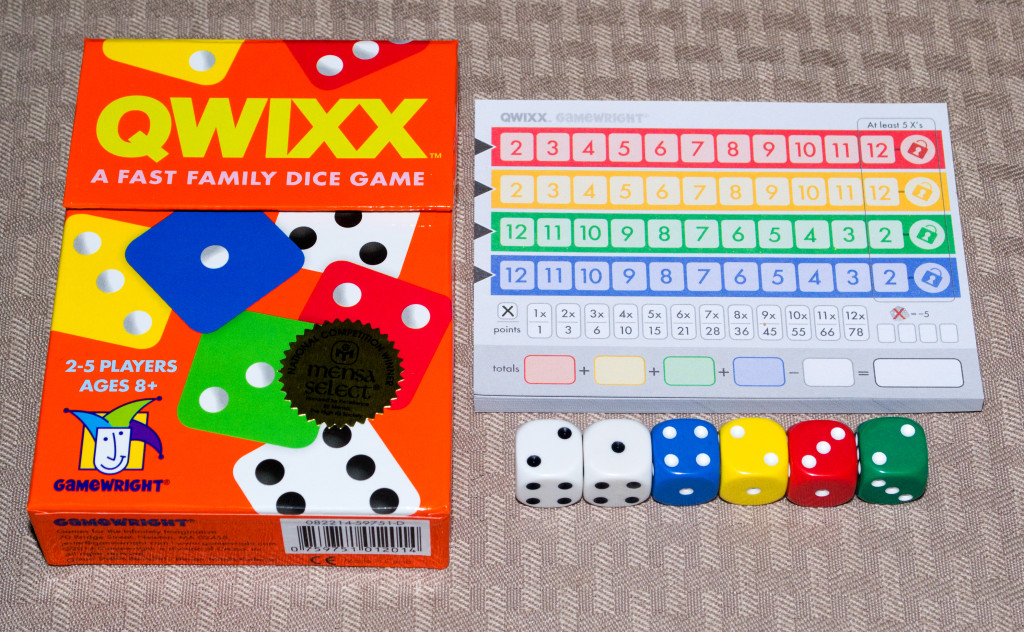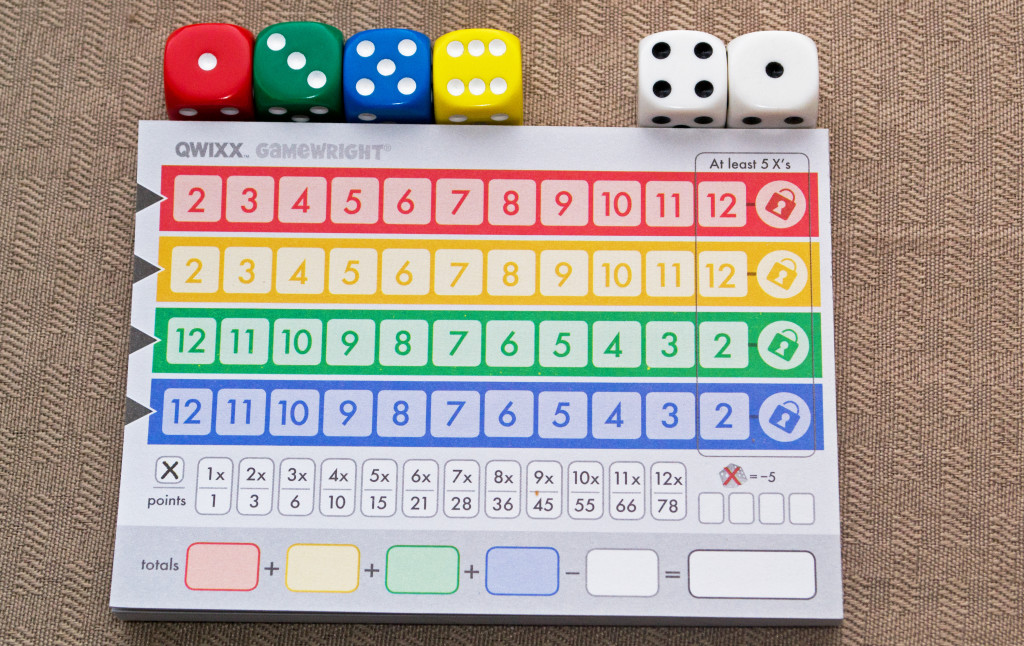Dice and I have a sort of an…erm…”understanding” in that they need to give me at least five good rolls during a single game or else they can roll themselves directly into the nearest incinerator. Surprisingly enough, nothing like that needed to be addressed when I first started playing “Qwixx”. Put simply, “Qwixx” will task players with crossing out as many numbers on their scorecard as they can in order to score the most points, though there are a few rules and gameplay mechanics that may sometimes encourage players not to. Before I get ahead of myself, I’d like to quickly thank Marketing Coordinator Nora Meiners from Ceaco/Gamewright for providing me with a free press copy for review purposes.
Components
The game includes six dice (two white, one red, one blue, one green and one yellow) and a scorepad.
You can buy more scoresheets from Gamewright’s official site here:
http://gamewright.shptron.com/p/qwixx-score-pads-2-pack
Or you can opt to print/use these less-flashy scoresheets I created in Excel (and saved as a PDF):
http://www.dadsgamingaddiction.com/wp-content/uploads/2015/02/Qwixx-Scoresheets.pdf
Setup & Gameplay
Setting up the game is very simple: everyone grabs a scoresheet and something to write with. Players randomly choose who will start the game as the “active player”. The role of the active player will rotate around the table clockwise at the end of a player’s turn.
On a player’s turn, they’ll roll all six dice. After that, the following two actions are carried out:
1. The active player adds the pips of the two white dice and says their total aloud. Each player has the option (and is not obligated to) cross out that number on one of any of the four colored rows.
2. The active player (and only the active player) adds the pips from one of the white dice and from one of any of the four colors. They’ll then cross out that number on that same colored row on their scorepad (again, they are not obligated to).
If the active player doesn’t cross out a number on their turn, they must cross out one of the empty penalty boxes. The non-active players need not worry about this rule.
Numbers must be crossed out from left to right and you can never backtrack. In order to cross out the number at the far-right end, a player must first cross out five numbers in that same row. If they do so, they’ll also cross out the “lock” and announce that they’ve done so: this color will no longer be rolled in future turns and players can no longer cross out numbers in that colored row.
The game ends when someone has marked their fourth penalty box OR when a total of two colors have been locked (regardless by which players). Players earn points for how many numbers they’ve crossed off on each row, as well as negative five points for each penalty. These points are summed across all four rows and whoever has the most, wins the game!
Editor’s Note: The above doesn’t cover all of the rules found in the manual, but should give you an idea as to how the game is played.
The Review
First and foremost, I like the fact that it is portable and can be played almost anywhere. After all, the entire game consists of just six dice and some scorepads. I do think that the game could have included more scorepads as you’ll tend to go through them quickly, though you can print/download my not-so-pretty version of the scoresheet for free. The first page is in color, the second one is not (for the benefit of those who can only print in black and white). The instructions were easy to read and provided plenty of pictures and examples.
Unlike some other dice games on the market, this one keeps players engaged no matter whose turn it is. While the active player gets to cross off a potential two numbers on their turn, other players will have the option of crossing off one. This mechanic is especially helpful in larger groups where there’s usually a lot of downtime waiting for your turn to roll back around. I also thought that making the red and yellow values ascend in numeric order and the green and blue values descend in numeric order was an interesting choice. This mechanic certainly gave us more choices as I didn’t find myself stuck rooting for just low/high values at the beginning/end of the game, respectively.
All in all, “Qwixx” is a great choice for an easy-to-play, family-friendly dice romp on family game night. It supports up to five players, which is great for families of five like mine. It’s easily recommendable at its current price tag of $10-$15 on Amazon (link below), though I do think that the replacement scoresheets offered through the official site are a bit pricey considering how quickly you’ll go through them.
Final Verdict: 8/10
—



There is an online version of Qwixx too if you are interested. https://botwise.games/info/qwixx